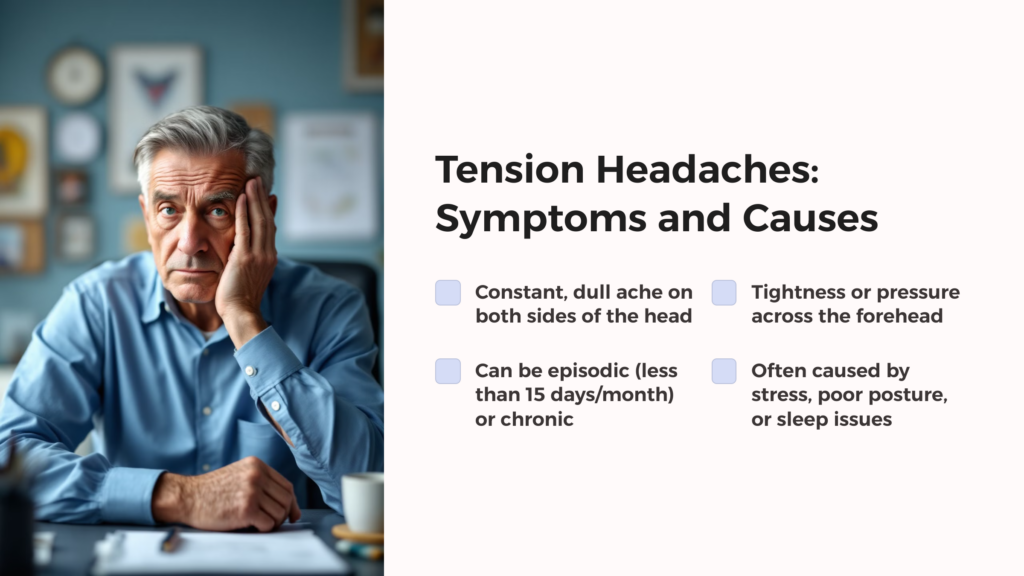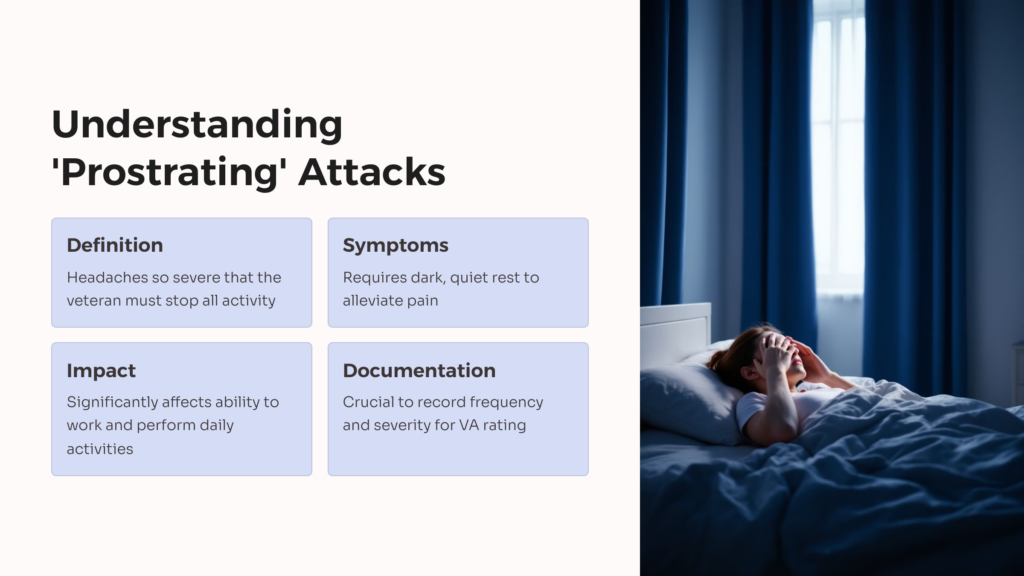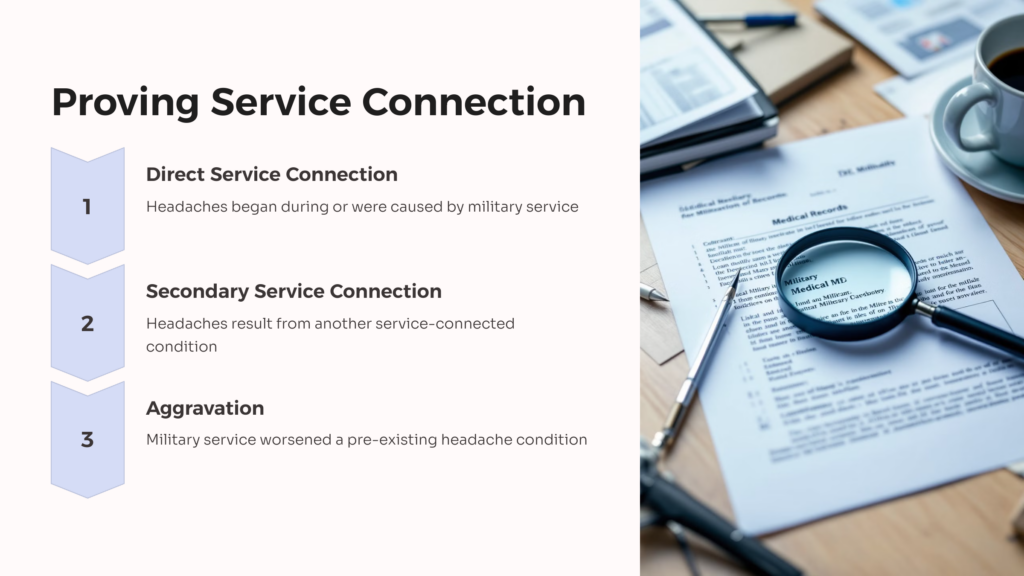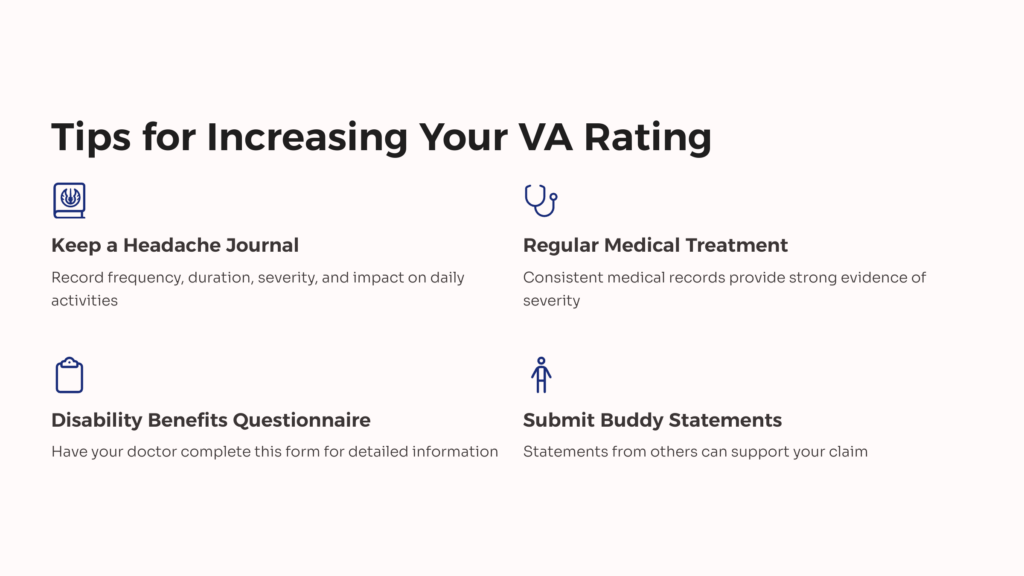
Tension headaches are the most common type of headache experienced by adults. They are characterized by a dull, aching pain that can feel like a tight band around the head. For veterans, these headaches can be particularly troublesome, often resulting from the physical and emotional stress of military service.
Tension headaches can be either episodic or chronic. Episodic tension headaches occur less than 15 days a month, while chronic tension headaches happen more frequently. Many veterans find that their headaches become more frequent or severe after their military service, leading them to seek VA disability benefits.
Understanding the nature of tension headaches is crucial for veterans pursuing a VA disability rating. These headaches, while not typically as severe as migraines, can still significantly impact daily life and work performance.
Symptoms and Causes of Tension Headaches
The primary symptom of tension headaches is a constant, dull ache on both sides of the head. Veterans may also experience tightness or pressure across the forehead or on the sides and back of the head. Unlike migraines, tension headaches don’t usually cause nausea or sensitivity to light and sound.
Common causes of tension headaches in veterans include:
- Stress from combat or military life
- Poor posture, often from long hours of standing or sitting in military vehicles
- Lack of sleep or irregular sleep patterns
- Dehydration, particularly in hot deployment locations
- Muscle strain in the neck and shoulders
- Anxiety or depression related to military experiences
For many veterans, these headaches are a direct result of their service conditions. Recognizing these causes can help in establishing a service connection when applying for VA disability benefits.
How VA Rates Tension Headaches
The VA rates tension headaches under the same criteria as migraine headaches, using Diagnostic Code 8100. This is because tension headaches, when severe and frequent enough, can be just as disabling as migraines.
The VA considers several factors when assigning a rating:
1. Frequency of headaches
2. Severity of headaches
3. Economic impact on the veteran’s life
Ratings for headaches can range from 0% to 50%, depending on how much they affect the veteran’s ability to work and perform daily activities. It’s important to note that even a 0% rating can be beneficial, as it establishes service connection and may allow for future increases if the condition worsens.
Diagnostic Code 8100 Explained
Diagnostic Code 8100 is the VA’s classification for migraine headaches, which is also used for rating tension headaches. Understanding this code is crucial for veterans seeking compensation for their headache condition.
The code breaks down ratings as follows:
- 50%: Very frequent completely prostrating and prolonged attacks productive of severe economic inadaptability
- 30%: Characteristic prostrating attacks occurring on average once a month over last several months
- 10%: Characteristic prostrating attacks averaging one in 2 months over last several months
- 0%: Less frequent attacks
Key to understanding these ratings is the term “prostrating.” The VA considers a headache prostrating when it’s so severe that the veteran must stop all activity and seek dark, quiet rest.

Criteria for Different VA Ratings
To receive a 50% rating, the highest available for headaches, veterans must demonstrate that their headaches are:
1. Very frequent
2. Completely prostrating and prolonged
3. Productive of severe economic inadaptability
This means the headaches occur multiple times per month, are severe enough to require complete rest, and significantly impact the veteran’s ability to work.
A 30% rating requires prostrating attacks occurring on average once a month. For a 10% rating, these attacks should occur every two months. Even if headaches occur less frequently, a veteran may still receive a 0% rating, which acknowledges the service connection of the condition.
It’s important to provide detailed documentation of headache frequency, severity, and impact on daily life when applying for these ratings.
Proving Service Connection for Tension Headaches

Establishing a service connection is crucial for receiving VA benefits for tension headaches. Veterans must show that their headaches are related to their military service. This can be done in several ways:
1. Direct Service Connection: Proving the headaches began during service or were caused by an in-service event.
2. Secondary Service Connection: Showing the headaches are a result of another service-connected condition, such as PTSD or a neck injury.
3. Aggravation: Demonstrating that military service worsened a pre-existing headache condition.
To prove service connection, veterans should gather:
- Service medical records showing treatment for headaches
- Statements from fellow service members who witnessed the headaches
- Current medical records documenting ongoing headache issues
- A nexus letter from a doctor linking the headaches to military service
Remember, the key is to show a clear link between your current headache condition and your time in the military.
Tips for Increasing Your VA Rating

If you’re seeking to increase your VA rating for tension headaches, consider these strategies:
1. Keep a detailed headache journal. Record frequency, duration, severity, and impact on daily activities.
2. Get regular medical treatment. Consistent medical records provide strong evidence of your condition’s severity.
3. Consider a Disability Benefits Questionnaire (DBQ). Have your doctor complete this form to provide the VA with detailed information about your condition.
4. Submit buddy statements. Statements from family, friends, or coworkers can support your claim by describing how headaches affect your daily life.
5. Be specific in your claim. Clearly describe how your headaches impact your ability to work and perform daily tasks.
Remember, the VA needs to understand the full impact of your headaches on your life to assign an appropriate rating.
Common Mistakes to Avoid in VA Claims
When filing for VA disability for tension headaches, avoid these common pitfalls:
1. Underreporting symptoms: Be honest and thorough about your headache frequency and severity.
2. Lack of medical evidence: Regular doctor visits and treatments strengthen your claim.
3. Inconsistent statements: Ensure your descriptions of headaches are consistent across all documentation.
4. Missing deadlines: Pay attention to all VA deadlines and respond promptly to requests for information.
5. Not appealing a decision: If you disagree with a rating decision, don’t hesitate to appeal.
By avoiding these mistakes, you increase your chances of receiving an accurate rating for your tension headaches.
Frequently Asked Questions About VA Ratings for Headaches
1. Can I get VA disability for tension headaches? Yes, if you can prove they are service-connected.
2. What’s the highest VA rating for headaches? The maximum rating for headaches is 50%.
3. How often do I need to have headaches to qualify for a rating? It depends on the rating level. For a 10% rating, prostrating attacks should occur every two months on average.
4. Can I work and still receive a high rating for headaches? Yes, but your ability to work consistently may affect your rating.
5. What if my headaches are secondary to another condition? You can claim secondary service connection if the primary condition is service-connected.
Resources and Support for Veterans
Veterans seeking help with their tension headache claims have several resources available:
1. VA.gov: Official source for VA benefits information and online claim filing.
2. Veterans Service Organizations (VSOs): Offer free assistance with filing claims and appeals.
3. VA Medical Centers: Provide treatment and documentation for headache conditions.
4. Veterans Disability Info: Offers detailed information about VA ratings for headaches.
5. Support Groups: Connect with other veterans experiencing similar issues for advice and support.
Remember, you’re not alone in this process. Reach out to these resources for guidance and support in securing the benefits you’ve earned through your service. Take our free medical evidence screening at AllVeteran.com today and begin your journey.
 AllVeteran.com Advisors
AllVeteran.com Advisors
With expertise spanning local, state, and federal benefit programs, our team is dedicated to guiding individuals towards the perfect program tailored to their unique circumstances.











